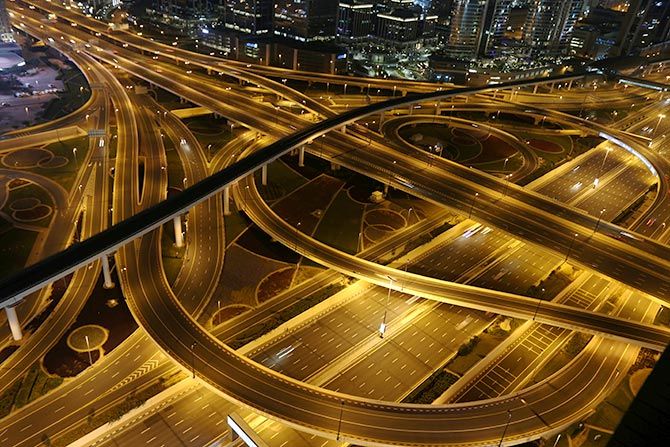Closures, travel restrictions, and self-isolation measures due to the coronavirus have cleared public squares, roads, and travel destinations across the globe.
Photographers have been capturing the eerie stillness of these public spaces, recently emptied of the crowds they were built for.

Aerial view of light traffic in 9 de Julio Avenue and the Obelisk in Buenos Aires, Argentina. National government extended obligatory isolation until April 26. Meanwhile, measures are being analyzed to alleviate the economic impact of the pandemic. Photograph: Getty Images

A view of Blaxland Riverside Park playground in Silverwater which is currently closed in Sydney, Australia. Playgrounds, outdoor exercise equipment, basketball courts, skate parks and water play areas in parks are closed across New South Wales to comply with Australian government regulations to reduce the spread of COVID-19. Photograph: Cameron Spencer/Getty Images

Light traffic during the evening rush hour on South Figueroa Street and the I-110 freeway amid the coronavirus pandemic in Los Angeles, California. Photograph: Mario Tama/Getty Images

A view of Paulista Avenue during the coronavirus pandemic in Sao Paulo, Brazil. Photograph: Alexandre Schneider/Getty Images

A nearly empty interchange at North Luzon Expressway in Valenzuela, Metro Manila, Philippines. Philippine President Rodrigo Duterte has ordered law enforcement to "shoot" residents caught violating quarantine rules during a month long lockdown in the country to contain the spread of the coronavirus. The Philippines' main island Luzon, which includes capital Manila, has been on lockdown for more than two weeks. Land, sea, and air travel has been suspended, while government work, schools, businesses, and public transportation have been ordered shut in a bid to keep some 55 million people at home. Photograph: Ezra Acayan/Getty Images

The Reforma street in Mexico City, Mexico. After being criticised for its slow response to the virus, Mexican government announced the health emergency nationwide and suspended all non-essential jobs until April 30. Photograph: Hector Vivas/Getty Images

A view of San Francisco, California. Photograph: Justin Sullivan/Getty Images

The Kaiser Wilhelm Memorial Church stands over nearly empty Breitscheidplatz square during the coronavirus crisis in Berlin, Germany. The coronavirus and the disease it causes, COVID-19, are having a fundamental impact on society, government and the economy in Germany. Public life has been restricted to the essentials in an effort by authorities to slow the spread of infections. Photograph: Sean Gallup/Getty Images

The deserted main roads behind a statue of General Sudirman in Jakarta following the imposition of large-scale social restrictions by the government to prevent the spread of the coronavirus disease in Jakarta, Indonesia. Photograph: Antara Foto/Sigid Kurniawan/Reuters

An aerial view shows less than usual passersby seen at a pedestrian crossing at Ginza shopping and amusement district after Tokyo Governor Yuriko Koike urged Tokyo residents to stay indoors in a bid to keep the coronavirus disease from spreading, in Tokyo, Japan. Photograph: Kyodo/Reuters

The deserted Place de l'Etoile and the Arc de Triomphe, during a lockdown imposed to slow the spread of the coronavirus disease in Paris, France. Photograph: Pascal Rossignol/Reuters

The Sheikh Zayed Road, following the outbreak of coronavirus disease, in Dubai, United Arab Emirates. Photograph: Satish Kumar/Reuters

An aerial view of the deserted Hooghly Bridge during the nationwide lockdown over coronavirus outbreak, in Kolkata. Photograph: ANI Photo

The deserted Bandra-Worli Sealink during the nationwide lockdown to limit the spreading of COVID-19 in Mumbai. Photograph: ANI Photo














